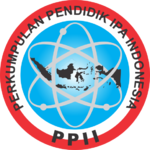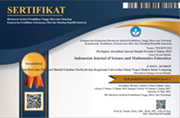Ethnosciences learning related to socioscientific issues: Problems asked, science answered
Abstract
Keywords
Full Text:
PDFReferences
R. A. Fasasi, “Effects of ethnoscience instruction, school location, and parental educational status on learners’ attitude towards science,” Int. J. Sci. Educ., vol. 39, no. 5, pp. 548–564, 2017, doi: https://doi.org/10.1080/09500693.2017.1296599.
A. Muliadi, M. Sarjan, and J. Rokhmat, “Pembelajaran IPA Berbasis bioentrepreneur pada etnosains poteng jaje tujak : perspektif filsafat,” JPIn J. Pendidik Indones., vol. 5, no. 2, pp. 50–70, 2022.
Y. F. Kasi, A. Samsudin, A. Widodo, and R. Riandi, “A thematic review on exploring ethnoscience in science education: a case in Indonesia,” Tadris J. Kegur. dan Ilmu Tarb., vol. 6, no. 2, pp. 229–241, 2021, doi: https://doi.org/10.24042/tadris.v6i2.9509.
C. Damayanti, A. Rusilowati, and S. Linuwih, “Pengembangan model pembelajaran IPA terintegrasi etnosains,” J. Innov. Sci. Educ., vol. 6, no. 1, pp. 116–128, 2017.
F. Andayani and A. N. Lathifah, “Analisis kemampuan pemecahan masalah siswa smp dalam menyelesaikan soal pada materi aritmatika sosial,” J. Cendekia J. Pendidik. Mat., vol. 3, no. 1, pp. 1–10, 2019, doi: https://doi.org/10.31004/cendekia.v3i1.78.
A. A. Rohmawati and W. Fadly, “Analisis kemampuan membuat solusi melalui kegiatan eksperimen,” J. Tadris IPA Indones., vol. 3, no. 1, pp. 9–19, 2023, doi: https://doi.org/10.21154/jtii.v3i1.1273.
A. T. Kinslow, T. D. Sadler, and H. T. Nguyen, “Socio-scientific reasoning and environmental literacy in a field-based ecology class,” Environ. Educ. Res., vol. 25, no. 3, pp. 388–410, 2019, doi: https://doi.org/10.1080/13504622.2018.1442418.
N. Subekti and A. Fibonacci, “Model pembelajaran kimia berbasis etnosains [MPKBE] untuk mengembangkan literasi sains siswa,” pp. 83–90, 2014.
A. Widyawati, S. I. A. Dwiningrum, and R. Rukiyati, “Pembelajaran ethnosciences di era revolusi industri 4.0 sebagai pemacu Higher Order Thinking Skills (HOTS),” J. Pembang. Pendidik. Fondasi dan Apl., vol. 9, no. 1, pp. 66–74, 2021, doi: https://doi.org/10.21831/jppfa.v9i1.38049.
R. Khishfe, “Consistency of nature of science views across scientific and socio-scientific contexts,” Int. J. Sci. Educ., vol. 39, no. 4, pp. 403–432, 2017, doi: doi: https://doi.org/10.1080/09500693.2017.1287976.
R. M. Molinini et al., “Measuring early problem-solving in young children with motor delays: a validation study,” Phys. Occup. Ther. Pediatr., vol. 41, no. 4, pp. 390–409, 2021, doi: https://doi.org/10.1080/01942638.2020.1865501.
A. A. Ningrum and H. N. Fauziah, “Analisis kemampuan berfikir reflektif dalam menyelesaikan permasalahan berbasis isu sosial ilmiah ditinjau dari perbedaan gender,” J. Tadris IPA Indones., vol. 1, no. 2, pp. 87–98, 2021, doi: https://doi.org/10.21154/jtii.v1i2.158.
R. W. Weisberg, “Toward an integrated theory of insight in problem solving,” Think. Reason., vol. 21, no. 1, pp. 5–39, 2015, doi: https://doi.org/10.1080/13546783.2014.886625.
K. J. Gilhooly, G. J. Georgiou, M. Sirota, and A. Paphiti-Galeano, “Incubation and suppression processes in creative problem solving,” Think. Reason., vol. 21, no. 1, pp. 130–146, 2015, doi: https://doi.org/10.1080/13546783.2014.953581.
R. Levinson, P. Kent, D. Pratt, R. Kapadia, and C. Yogui, “Developing a pedagogy of risk in socio-scientific issues,” J. Biol. Educ., vol. 45, no. 3, pp. 136–142, 2011, doi: https://doi.org/10.1080/00219266.2011.576260.
L. F. Main, M. A. B. Delcourt, and D. J. Treffinger, “Effects of group training in problem-solving style on future problem-solving performance,” J. Creat. Behav., vol. 53, no. 3, pp. 274–285, 2019, doi: https://doi.org/10.1002/jocb.176.
I. Khairani and R. Safitri, “Penerapan metode pembelajaran problem solving untuk meningkatkan hasil belajar peserta didik pada materi usaha dan energi di man Rukoh Banda Aceh,” J. Pendidik. Sains Indones., vol. 5, no. 2, pp. 32–40, 2018, doi: https://doi.org/10.24815/jpsi.v5i2.9814.
N. Nurhayati, L. Yuliati, and N. Mufti, “Pola penalaran ilmiah dan kemampuan penyelesaian masalah sintesis fisika,” J. Pendidik. Teor. Penelitian, dan Pengemb., vol. 1, no. 8, pp. 1594–1597, 2016.
N. I. Wulansari and S. Admoko, “Eksplorasi konsep fisika pada tari dhadak merak reog Ponorogo,” PENDIPA J. Sci. Educ., vol. 5, no. 2, pp. 163–172, 2021, doi: https://doi.org/10.33369/pendipa.5.2.163-172.
M. Lindfors, M. Bodin, and S. Simon, “Unpacking students’ epistemic cognition in a physics problem-solving environment,” J. Res. Sci. Teach., vol. 57, no. 5, pp. 695–732, 2020, doi: https://doi.org/10.1002/tea.21606.
J. A. Luft, D. Hanuscin, L. Hobbs, and G. Törner, “Out-of-field teaching in science: an overlooked problem,” J. Sci. Teacher Educ., vol. 31, no. 7, pp. 719–724, 2020, doi: https://doi.org/10.1080/1046560X.2020.1814052.
U. N. Hamidah and F. A. M. Mubarak, “Analysis of students’ ability to making conclusions in learning of static electricity,” Integr. Sci. Educ. Teach. Act. J., vol. 1, no. 1, pp. 1–16, 2020, doi: https://doi.org/10.21154/insecta.v1i1.2079.
K. D. P. M. Dwijayanti and E. N. Savitri, “The development of testlet assessment instrument model integrated with e-ujian website to measure the higher-order thinking skills,” Tadris J. Kegur. dan Ilmu Tarb., vol. 7, no. 1, pp. 47–61, 2022, doi: https://doi.org/10.24042/tadris.v7i1.10939.
J. Munthahana and M. T. Budiarto, “Ethnomathematics exploration in panataran temple and its implementation in learning,” Indones. J. Sci. Math. Educ., vol. 3, no. 2, pp. 196–209, 2020, doi: https://doi.org/10.24042/ijsme.v3i2.6718.
C. A. McKim, “The value of mixed methods research: a mixed methods study,” J. Mix. Methods Res., vol. 11, no. 2, pp. 202–222, 2017, doi: https://doi.org/10.1177/1558689815607096.
M. L. Maciejewski, “Quasi-experimental design,” Biostat. Epidemiol., vol. 4, no. 1, pp. 38–47, 2020, doi: https://doi.org/10.1080/24709360.2018.1477468.
D. Firmansyah and Dede, “Teknik pengambilan sampel umum dalam metodologi penelitian: literature review,” J. Ilm. Pendidik. Holistik, vol. 1, no. 2, pp. 85–114, 2022, doi: https://doi.org/10.55927/jiph.v1i2.937.
S. Abutabenjeh and R. Jaradat, “Clarification of research design, research methods, and research methodology: A guide for public administration researchers and practitioners,” Teach. Public Adm., vol. 36, no. 3, pp. 237–258, 2018, doi: https://doi.org/10.1177/0144739418775787.
B. W. Khairunnisa, “Model concurrent transformative dalam desain metode penelitian campuran: sebuah pengenalan,” Syntax Idea, vol. 3, no. 9, pp. 2072–2081, 2021, doi: https://doi.org/10.46799/syntax-idea.v3i9.1488.
S. Susanti, A. Asyhari, and R. Firdaos, “Efektivitas LKPD terintegrasi nilai islami pada pembelajaran berbasis masalah untuk meningkatkan kemampuan literasi sains,” Indones. J. Sci. Math. Educ., vol. 2, no. 1, pp. 64–78, 2019, doi: https://doi.org/10.24042/ijsme.v2i1.3987.
J. Jufrida, F. R. Basuki, A. Xena, and P. Pasminingsih, “Pengembangan buku IPA berbasis kearifal lokal Jambi pada materi tekanan serta getaran dan gelombang,” Indones. J. Sci. Math. Educ., vol. 2, no. 3, pp. 287–297, 2019, doi: https://doi.org/10.24042/ijsme.v2i3.4353.
D. A. S. Ningsih and H. Komikesari, “Kelayakan media pembelajaran prezi menggunakan pendekatan saintifik,” Indones. J. Sci. Math. Educ., vol. 2, no. 2, pp. 204–209, 2019, doi: https://doi.org/10.24042/ijsme.v2i2.4344.
F. Fajria, H. Rahmatan, and A. Halim, “Dampak model pembelajaran problem solving terhadap motivasi dan hasil belajar peserta didik di SMP,” J. Pendidik. Sains Indones., vol. 5, no. 2, pp. 86–93, 2018, doi: https://doi.org/10.24815/jpsi.v5i2.9822.
A. E. Anggraini, “Pengaruh metode pictorial riddle yang dimodifikasi dengan pendekatan scientific terhadap hasil belajar perserta didik pada materi gerak lurus,” B.S. Thesis, Dept. Educ. and Teach., UIN Raden Intan Lampung, Indonesia, 2018.
B. Brown, G. Pérez, K. Ribay, P. A. Boda, and M. Wilsey, “Teaching culturally relevant science in virtual reality: ‘when a problem comes, you can solve it with science,’” J. Sci. Teacher Educ., vol. 32, no. 1, pp. 7–38, 2021, doi: https://doi.org/10.1080/1046560X.2020.1778248.
E. Sujarwanto, “Pemahaman konsep dan kemampuan penyelesaian masalah dalam pembelajaran fisika,” Diffraction, vol. 1, no. 1, pp. 22–33, 2019.
S. Sulastri and F. N. Pertiwi, “Problem based learning model through constextual approach related with science problem solving ability of junior high school students,” INSECTA Integr. Sci. Educ. Teach. Act. J., vol. 1, no. 1, pp. 50-58, 2020, doi: https://doi.org/10.21154/insecta.v1i1.2059.
A. Amam, “Penilaian kemampuan pemecahan masalah matematis siswa SMP,” Teorema, vol. 2, no. 1, pp. 39-46, 2017, doi: https://doi.org/10.25157/.v2i1.765.
B. Rubini, “Using socio-scientific issues in problem based learning to enhance science literacy,” Journal of Physics: Conference Series, vol. 1233, no. 1, pp. 1-4, 2019. doi: https://doi.org/10.1088/1742-6596/1233/1/012073.
DOI: http://dx.doi.org/10.24042/ijsme.v7i1.19816
Refbacks
- There are currently no refbacks.
Copyright (c) 2024 Unit Riset dan Publikasi Ilmiah FTK UIN Raden Intan Lampung

This work is licensed under a Creative Commons Attribution-ShareAlike 4.0 International License.

Indonesian Journal of Science and Mathematics Education is licensed under a Creative Commons Attribution-ShareAlike 4.0 International License.




